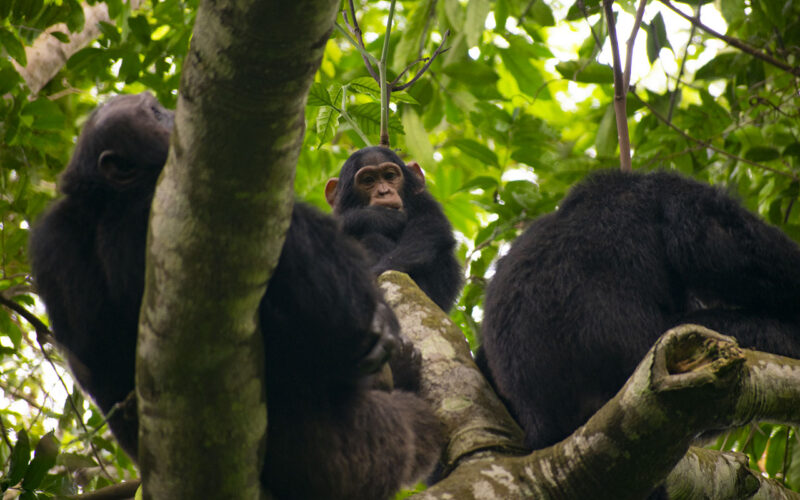Kibale National Park is the primate’s capital with up to 13 species of primates including the Chimpanzee. Kibale Forest ranks the best destination for chimpanzee trekking experience known for its highly knowledgeable ranger guides and well habituated chimp communities. This medium-altitude forest park spreads across the eastern escarpment walls of the rift valley, connecting to the savanna plains of Queen Elizabeth National Park creating a migration corridor for elephants and buffalos. In the west, the Kibale NP overlooks the Rwenzori Mountains ranges also called the “mountains of the moon”. With the rainfall in the excess 1400mm this tropical forest boasts of varied eco zones supporting a rich flora and fauna. The nearby volcanic epicenter of Ndali-Kasenda region lies on the north-west part of the park and a great bonus to explore.
Kibale National Park Quick Facts
- Size:766km2
- Gazetted in 1993
- Distance: 330 km/5hrs from Kampala
- Altitude: 600-1590m
- Birds: 375 bird species
- Mammals: 70 mammal species
- Trees: 351 species
- Butterflies: 250 species

Things to do in and around Kibale National Park
-
Chimpanzee Tracking and Habituation Experience
A major highlight at Kibale Forest NP, is a guided trekking experience along a community of Chimpanzee in this native forest home of these great apes. The forest ranks as a top Chimp tracking destination in the region owing to its “almost guaranteed” chances for a face-to-face interaction with the chimpanzee. With the largest communities of habituated chimpanzee available for tracking, Kibale Forest offers normal and habituation programs scheduled for both morning and afternoon
On a normal tracking experience day, visitors check in at the Kanyanchu visitor’s center, where they are briefed and further grouped into smaller groups to be guided along and across various forest trails to locate the chimpanzee communities’ feeding ranges. The Kibale NP’s ranger guides have had a long time working with chimpanzee and leading the trekkers on the trek, share their vast knowledge on various tree species preferred by these apes and interpreting various calls and tracks encountered on the trails. When you locate the chimpanzee, the clients are accorded a full one hour, observing the human-like behavior, watching interactions and activity of these now-highly endangered species in their native forest home. The experience often lasts between 3-5hrs.
On a habituation tracking experience however, a limited number of visitors (max 4) join the research and a ranger team to follow a semi-habituated chimpanzee community undergoing this program. It starts at 7am, to target the chimpanzee as they leave their nests, get to follow them as they forage meanwhile gaining in-depth insights and knowledge into the complex society of this man’s closest relative ape. Visitors here get to spend up to 4-hrs with this community of chimpanzee.
Kibale Forests’ other list of primates include a race of Red-colobus Monkey, Grey-checked Mangabey, L’hoest, Red-tailed and Blue Monkey occur in these forests. The rich forest also host up to 250 species of butterflies and a heathy tree specie-list that are unique to this ancient forest.
-
Bird Watching
Kibale National Park Forest is Uganda’s top birding hotspot re-known for its reliable chances to encounter the elusive, Green-breasted Pitta. The shy dense forest resident is seen with better chances during the breeding season as males put on spectacular displays and calls to attract females, other seasons the action is slow and can be easily under looked.
Kibale Forest’s varied habitats attracts other restricted-range biome, Guinea-Congo biomes and Albertine Rift Endemics Nahan’s Francolin, African Grey Parrots, African Emerald Cuckoo, Cassin’s Hawk-eagle, Dusky Tit, and the magnificent Great-blue Turaco among a host of 370 species.
-
See nature up-close on guided Forest Walks at Kibale NP
Varied options of day-walks are available at Kibale NP that suit one’s interests exploring diverse sections of the forest along well-maintained network of trails. The most popular one is a 14-km walk that exposes one to a typical mature tropical forest with century-old mahogany trees rising to over 70m to various ancient fig trees that are frequented by nearby troops of chimpanzee.
The riverine section also is frequented by seasonal migrating savanna elephants that come to feed on the mineral-rich sandy clay soils and palm trees. Various primates, birds, butterflies and a scenic forest structure are encountered along this walk. These guided-nature walks stretch anywhere from 4-8 hrs while longer options include full-to-multi day hikes across this vast forest.
-
Explore the Scenic Fort Portal and Ndali/Kasenda Crater Lakes
Fort Portal Town is the capital of Toro kingdom whose palace overlooks this tourism capital of Uganda. Set along the rift valley escarpment and overlooking Rwenzori mountains, the scenic landscape of green hills and lush tropical forests, is pocked by several crater lakes and calderas that are evidence of major geological forces and provide the best adventure options.
With time on your hands, take a hike through the sparkling crater areas to appreciate great scenery, beautiful tea plantations, coffee and banana gardens. Interact with the friendly people and test a variety of local traditional menu this region is known for.
The high altitude of Fort portal gives it cool temperatures of average 200 C making it an ideal base to visit nearby attractions including short hikes to Rwenzori Mountains, hot springs in Semuliki NP and chimpanzee tracking in Kibale NP.
-
Take a Birding or just a Nature Walk at Bigodi Wetland
Close to Kibale National Park is this highly recommended community run and protected papyrus and river-line forest habitat where a walk through its well-excellent trails produces a juicy species checklist associated to forest edge and moist habitats; Shinning-blue Kingfisher, White-spotted Flufftail, Joyful Greenbul, Yellow-throated Tinkerbird, Yellow-crested Woodpecker, Speckled Tinkerbird, Black-necked Weaver, Red-headed Malimbe, African Pied Hornbill and many others. Over 8 species of primates occur in the riverine forest including Red-Colobus, Red-tailed, and Uganda Mangabey, further a walk through the community connects a visitor to various agricultural practices, traditions and culture of the local people.
